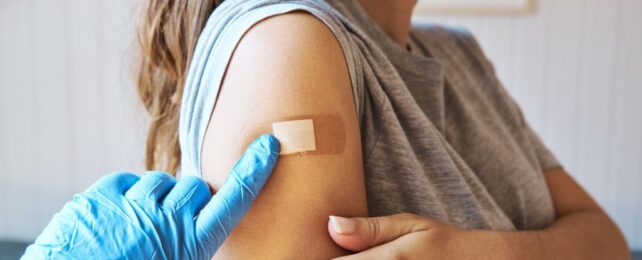Sometimes it's the simplest solutions that get lost in the kerfuffle of scientific progress.
Since the advent of vaccines more than two centuries ago, researchers have studied all sorts of ways in which inoculation with a weakened pathogen (or parts thereof) can prepare the immune system for a full attack – exploring different dosages, vaccine agents, and forms of administration.
In all that time, very few experts have investigated the question: Does it matter which arm gets vaccinated?
Researchers at Oregon Health & Science University (OHSU) suspect that it just might.
It all started in the early days of the COVID-19 pandemic. Healthcare workers participating in studies on immune response to the new COVID-19 vaccines were asking experts at OHSU whether they should switch arms between the first and second jab.
The team wasn't sure what advice to give. Until that time, most scientists had just assumed that it didn't matter.
"This question hasn't really been extensively studied, so we decided to check it out," says infectious disease specialist Marcel Curlin.
When Curlin and his colleagues combed through the scientific literature, they could only find four papers on the topic. And the results were mixed.
One randomized controlled trial among infants found that influenza vaccinations given at 2, 3, and 4 months of age in different arms resulted in higher antibody levels than they did when given in the same arm.
A more recent study in 2023, however, found higher immune responses after giving COVID-19 vaccinations in the same arm as opposed to different arms.
To get a clearer picture, researchers at OHSU tested the antibody levels of 947 participants who received a two-dose COVID-19 vaccination.
Half of the cohort were randomized to get the second dose in the same arm as the first one, while the other half received the staggered jabs in different arms. Four weeks after their second dose, SARS-CoV-2-specific serum antibodies were 1.4 fold higher in those who received the vaccine in different arms.
A subset of 108 people in 54 pairs were matched based on their gender, age, and time of vaccinations, and their blood work was compared.
Serum samples collected in the weeks and months after vaccination showed clear differences between the groups. Four weeks after the second jab, those who received shots in both arms had up to a four-fold increase in SARS-CoV-2-specific serum antibodies compared to those who got shots in just one arm.
What's more, this improved immune response lasted more than a year after the booster was administered.
"It turned out to be one of the more significant things we've found, and it's probably not limited to just COVID vaccines," Curlin hypothesizes.
"We may be seeing an important immunologic function."
Curlin and his colleagues are not yet sure what that special function is, or how it works, but they have an idea.
When a vaccine is given in muscle, the antigens in the medicine are recognized by immune cells, which 'handcuff' the invaders and take them to the lymph nodes for further questioning. This then primes the immune system against this particular antigen by sort of sending out wanted signs of the invader.
The thing is, different sides of the body drain to different lymph nodes, so by triggering an immune response on both sides, the body may be more on guard.
"By switching arms, you basically have memory formation in two locations instead of one," explains Curlin.
That's the opposite to what the 2023 study found. It suggested that same-arm vaccinations better prepared the immune system for COVID-19. The reason for the differing results could be due to the timing of serum blood tests.
The 2023 study tested blood serum just two weeks after the vaccinations were given.
The immune cells that memorize the characteristics of an antigen, however, continue to ramp up and mature for many months after vaccination.
Only at three weeks did researchers at OHSU notice that injections in both arms began to show better results than the same arm, and these benefits improved incrementally, hitting a peak at week 4 and lasting for many months after.
While more research needs to be done to understand the pros and cons of vaccinating different arms, Curlin says he won't hesitate to switch it up for his next booster.
The study was published in The Journal of Clinical Investigation.
